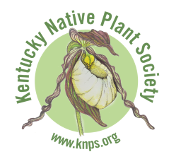Ann Longsworth
Railroad tracks ran along the end of our small backyard,
along the edge where brambles grew, the occasional hobo slept, and Mother and I
examined leaves and gathered wildflowers. From this seed planted long
ago, a lifelong love of wildflowers grew. Many years later, this city kid
bought nine rugged acres in Madison County, Kentucky. I named the property
“Jean’s Glade,” after my mother. The first year was spent bush
whacking and building a small home. The second year, I started exploring the
property and discovered what turned out to be Gentiana flavida, a
Kentucky state endangered species and the largest documented population at that
time. So began a twenty-year odyssey.
I had a lot of questions about this plant and set out to
find answers. First, how to positively identify the plant. Dr. Ralph Thompson,
to whom Jean’s Glade owes much, identified the plant and collected the voucher
specimen, currently housed in the Ralph Thompson Herbarium at Eastern Kentucky
University. Next, how should I manage the plant? Heather Housman, formerly of
the State Nature Preserves, was an incredible asset in this process. I
chainsawed eight 110-year-old cedars. Staff with the Landowner Incentive
Program removed numerous saplings, as did Josie Miller and Nathan Skinner, one
winter day. With more exposure to the sun, what was originally 129 gentians
became 634 at last count (I continue to remove woody plants, an ongoing job).
Finally, should the plant be studied? Dr. Chris Adams of
Berea College and Dr. Ralph Thompson, Berea College retiree, completed the
floristic study of the gentians which was published in Phytoneurexon, 2017-83: 1-25.
Other studies to come: germination requirements of Gentiana flavida and
isolating the mycorrhiza associated with the plant.
At Jean’s Glade, gentians grow on a south-west facing
slope. They occur in a small prairie inclusion and in the open mixed
hardwood/cedar forest edging the meadow. Gentiana flavida is a sun
loving perennial that is recruited by seed. They bloom August through September
and are pollinated by bumblebees. According to Drs. Adam and Thompson,
“Gentiana flavida populations are imperiled throughout much of their
distribution range because of extreme habitat loss primarily from anthropogenic
disturbances, forest expansion, absence of fire, and invasive grasses and forbs.”
The efforts I’ve made for the gentians may read as if it
was a trouble-free path. Nothing could be further from the truth! Along my
journey, I encountered years of what seemed to be insurmountable problems, read
stacks of literature, cold-called various researchers, professors, and authors,
visited a gentian site in Indiana, and mostly refused to take “No” or
“Can’t” for an answer. I have met many wonderful people because of
this plant and probably ruffled a few feathers, and let’s just say, the
electric company could probably describe to perfection “old Betsy” my
rather rusty hunting gun (not a recommended conservation tool, but effective).
Many things have changed in the past twenty year. “Miss
Jean” passed away five years ago. Now in my senior years, I face the
biggest challenge yet: how to preserve the Glade, knowing that I will need to
sell it in order to move closer to town soon. This may be one problem I am
unable to solve.
It is springtime at Jean’s Glade now. Titmice are calling, goldfinches are fussing, and the creek beside my house sounds like a sweetly flowing conversation. I can almost hear a voice saying, “Let’s take a nature walk!” And I would add, “While it’s still here, while it’s all still here.”
Ann Longsworth is a retired psychologist whose
avocation is Kentucky native plants. Two events sort of encouraged my pursuit
of native plants. First, we moved to Kentucky for my father’s work at Berea
College. The college property we moved to had lots of native plants. Second,
was my first short-term course at Berea College, which was at Pine Mountain
Settlement School. I also grow native plants and have a native plant fundraiser
sale (this year will be my eight) and give all of the proceeds to Monarch Watch
and/or nature projects.





